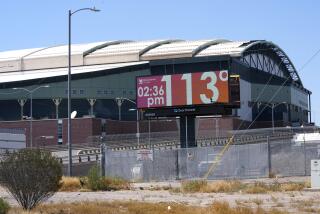Scientists Blow Hot and Cold on Global Warning Ideas : Weather: Researchers have found an increase in Earth’s temperature, but say it’s too soon to declare a trend. Also, it warms more at night in some places and more in the daytime elsewhere. Cloud cover may be a factor.
- Share via
WASHINGTON — Scientists trying to take the world’s rising temperature have discovered a data dilemma: It is warming more at night in some places and more in the daytime elsewhere.
American researchers reported last year that nighttime temperatures in much of the world were rising three times faster than daytime readings. But there have been conflicting studies. And some wonder aloud whether divergent cloud-cover patterns mostly account for the phenomenon.
Researchers have found, unmistakably, a general increase in the Earth’s temperature in recent years. But they generally agree that it’s too soon to declare a trend because the amount of temperature change is small enough to be considered part of normal climate variation.
Meteorologists in India found daytime temperatures going up faster than those at night in some areas, for example. Researchers in Switzerland found that day and night readings were up by about the same amount for mountain communities, though the valleys warmed more at night than in the daytime.
And a Washington climate conference last fall heard reports that no significant nighttime warming has occurred in polar regions, while some Pacific Islands have experienced equal day and night increases.
In general, studies of global temperatures suggest that nighttime minimum readings are rising faster than daytime maximums. But that doesn’t imply that everyone is in the same category.
“There are important reasons for differences from one place to another and many seem to be related to changes in cloud cover,” said Thomas Karl of the National Climatic Data Center in Asheville, N.C.
The findings are part of research into the threat of global warming. Scientists have voiced concern in recent years that chemicals released into the atmosphere by industry will turn the Earth into a sort of giant greenhouse, raising temperatures everywhere.
Scientists gathered in Berlin in April considered the possibility that there may even be a threat of global cooling--at least in industrialized nations where cloud cover is increased by pollutants.
The British magazine New Scientist reports that an unpublished study by Guy Brasseur and Mai Pham of the U.S. National Center for Atmospheric Research found that cooling exceeds warming over Europe, the eastern United States and parts of Russia, China and the Far East.
Increased cloudiness may be the reason that some areas have experienced more warming at night than in the daytime, Karl wrote in a paper in the Bulletin of the American Meteorological Society.
Warmer temperatures can cause more water to evaporate, leading to more clouds. Clouds can act as a blanket to prevent nighttime radiation cooling. They may also shade the Earth from the sun, cooling the daytimes.
“One of the problems is, we tend to say: ‘What’s the single cause of this?’ In truth there very rarely is a single cause,’ ” Karl said in a telephone interview.
If warming is concentrated at night, some researchers see possible benefits, such as a longer growing season and fewer killing frosts. And they say water evaporation, a threat in a warmer world, would be less likely if higher temperatures occurred at night.
On the other hand, nighttime warming might encourage crop pests. Also, there could be a shorter dormancy period, adversely affecting plant growth. And people might suffer more from heat waves with less nighttime cooling.
James Hansen of the National Aeronautics and Space Administration’s Goddard Institute for Space Studies, a pioneer in global warming research, cautioned against accepting claims that global warming is a “benign” nighttime trend.
In the long run, global warming will continue despite increased cloudiness or other factors that appear to be reducing its effect, he predicted in a paper presented to associates last year.
The uneven warming trend was first detailed by Karl and a team including George Kukla of Columbia University and Philip D. Jones of England’s University of East Anglia. They reported that between 1951 and 1990, average nighttime lows increased by 1.5 degrees Fahrenheit, while average daytime highs rose 0.5 degrees. In other words, nighttime warmed up more than daytime.
They studied the United States, Canada, the former Soviet Union, China, Japan, eastern Australia, Sudan and South Africa.
But, at 121 weather stations in India, average nighttime lows were unchanged between 1901 and 1987, while daytime highs rose about 1 degree, according to a report in the journal Geophysical Research Letters by meteorologists at the Indian Institute of Tropical Meteorology in Pune.
Kukla said that, too, is related to cloud cover. While clouds at middle and high latitudes lead to cooling in the daytime, it’s a different situation close to the Equator, he said.
“We by no means were claiming that changes are uniform all over the world, no way,” Kukla said.
A separate study of the period 1951-87, done for comparison with Karl’s report, could detect no overall temperature trend in India, researchers K. Rupta Kumar, K. Krishna Kumar and G. B. Pant reported in Geophysical Research Letters, published by the American Geophysical Union.
They didn’t try to explain why Indian findings differ from studies of other areas.
“No one has done an analysis of cloud changes in India since about 1960,” Karl said. “It would be very interesting to look at what’s happening to clouds (there).”






